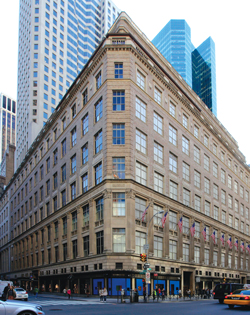After a run-up in pricing that even some of the industry’s most bullish observers find head spinning, Manhattan’s luxury retail market is starting to show cracks, and that could put its most active lenders on the line.
Big banks such as Wells Fargo, Bank of America, Deutsche Bank and France’s Crédit Agricole, as well as regional lenders such as M&T Bank and Signature Bank, are sitting on top of the largest loads of debt issued on Manhattan retail properties, according to data provided by research firms Actovia, Trepp, CrediFi and Real Capital Analytics. While there is not a deluge of troubled loans, should the market take a deep enough turn, several of those lenders could feel the backlash, industry observers told The Real Deal.
“The large retail lenders out there are exposed to a number of factors,” said Michael Korine, managing director of the finance and capital markets group at New York commercial real estate brokerage Berko & Associates [TRData]. “If the market does come down, it’s going to impact them.”
The mortgage data provider Actovia tallied $7.53 billion in loans originated on Manhattan retail properties in the past two years. The majority of those deals are being held on the banks’ books, while a portion of the debt was sent to the commercial mortgage-backed securities market. Securitized loans backed by Manhattan retail properties totaled $4.15 billion in June, according to the CMBS data firm Trepp. And as that market continues to grapple with “turbulence and a rising number of maturities, somebody’s going to have to refinance those loans,” Korine noted.
Of all the Manhattan CMBS retail loans outstanding, Trepp identified close to $600 million in deals that carry a low debt coverage ratio — a sign of limited cash flow and often of poor financial health.
680 Madison
The largest of those deals with a low debt coverage ratio is a $185 million loan Morgan Stanley originated in July 2014 to refinance Thor Equities’ 30,000-square-foot retail condo at the Helmsley Carlton House at 680 Madison Avenue. That loan matures in August and has a debt coverage ratio of just 0.2, down from 1.21 when the loan was securitized, according to notes from the loan’s servicer.

Michael Korine
Thor had penciled out revenues at $12.2 million a year and signed the property’s largest tenant, the Qatari luxury fashion brand Qela, to 6,200 square feet on two floors at about $2,000 per square foot on
the ground level, one of the priciest deals
of 2014.
But before the store even opened, Qela started shopping space last year, and in December Thor terminated the lease after Qela stopped paying rent, according to the loan servicer notes. No new tenant has been signed.
In addition, the property’s two other tenants — the high-end eyeglass shop Morgenthal Frederics and Italian tailor Brioni — are on free rent, which is generally offered as a concession during negotiations to lure new tenants. As a result, the property was running on a net operating loss of $313,834 during the first three months of the year on pro forma revenues of just over $2 million.
“You don’t see many loans with numbers that low,” Trepp research analyst Sean Barrie said, referring to the debt service ratio. “It looks like low occupancy is the smoking gun. Obviously, if you don’t have tenants paying rent, you don’t have the funds.”
Thor is currently looking to refinance the loan before it matures in August, according to the servicer, Berkadia.
Representatives at Thor and Morgan Stanley declined to comment.
Jim Costello, senior vice president at Real Capital Analytics, said that whether it’s high-end retail or mom-and-pop shops, lenders take on certain risks inherent to each segment of the retail sector.
“All the bodegas and the high-end shops on Fifth Avenue, there’s a capital source for those and all the points in between,” he said.
But what he’s really keeping his eye on is the money betting on the broad swath of retail in the middle of the market.
“The thing to worry about is the squeeze of everybody in the middle,” he said. “If some of the wealth created out of the stock market growth doesn’t show up again in the near term, that’s a problem.”
Blockbuster retail loans
Overall, one of the largest Manhattan retail debt deals of the past two years is the $1.25 billion loan that Canadian retail conglomerate Hudson’s Bay Company took out in late 2014 to refinance the ground under its Saks Fifth Avenue flagship store at 611 Fifth Avenue.
 That deal, led by Bank of America, valued the property at $3.7 billion, according to an independent appraisal commissioned by the lenders. Hudson’s Bay acquired the Saks retail chain, including the 650,000-square-foot Midtown store, in 2013 for $2.9 billion in a deal largely driven by the value of the real estate.
That deal, led by Bank of America, valued the property at $3.7 billion, according to an independent appraisal commissioned by the lenders. Hudson’s Bay acquired the Saks retail chain, including the 650,000-square-foot Midtown store, in 2013 for $2.9 billion in a deal largely driven by the value of the real estate.
But Saks, like many department stores, hasn’t been immune to some of the economic and other factors that have industry players concerned over a weakening retail market, especially at ultra high-end locations in Manhattan. Year-over-year sales at the chain store have been down for the last three quarters, with the company’s most recent report showing sales down 5.7 percent due to the stronger U.S. dollar’s negative effect on tourism and unfavorable weather. Representatives for Bank of America and Hudson’s Bay did not respond to requests for comment.
In another eyebrow-raising transaction, Deutsche Bank in April 2015 led a group of lenders including Goldman Sachs, Morgan Stanley and Citigroup on a separate $1.25 billion loan to finance Jeff Sutton’s and General Growth Properties’ purchase of the Crown Building on Fifth Avenue. Sutton and GGP acquired the property from Spitzer Enterprises and Winter Properties for $1.78 billion and sold the office portion on the building’s upper floors to Michael Shvo and Russian developer Vladislav Doronin for $500 million.
But while that deal raised eyebrows for its ambitious pricing, so far it appears to be panning out. Late last year, the sponsors signed the Italian luxury retailer Bulgari to a 3,000-square-foot, 15-year lease at a record $5,500 per square foot.
“In the case of sponsorship, GGP and Sutton are among the best sponsors in the industry,” said Ronnie Levine, a senior managing director at the commercial mortgage brokerage Meridian Capital Group, who was not involved in the deal. “Financing is a function of the quality of the sponsorship,” he added.
Representatives for Deutsche Bank, GGP and Sutton did not respond to requests for comment.
Wells Fargo also has a very sizeable portfolio of loans backed by Manhattan retail properties. In August, for instance, the bank lent $140 million to refinance SL Green Realty and Invesco Real Estate’s 65,500-square-foot Soho building at 131-137 Spring Street, where Burberry and Diesel are tenants.

Scott Aliese
During the same month Wells also took part in the $350 million refinancing of the 150,000-square-foot retail portion of 731 Lexington Avenue, in a syndicate deal with the German bank Landesbank Baden-Württemberg (LBBW) and JP Morgan Chase.
But aside from being one of the largest originators, Wells is also one of the biggest CMBS lenders in the country. That means it will be heavily impacted by the Federal Reserve’s stress test, which measures a bank’s ability to weather an event like an increase in unemployment or a drop in oil prices, and new rules on risk retention, which take effect at the end of the year.
“All the banks are going to have to think more about what they keep on their balance sheets,” RCA’s Costello said. “They had been doing an annual review of risk retention and now have to think about this on a quarterly basis.”
He added: “The Fed’s also been a little bit worried about banks that hold the loans for a bit and then sell off the losers when the [CMBS] market is hot.”
Another large retail loan in the past two years originated from Crédit Agricole. The French banking cooperative lent $450 million in December 2015 to refinance the St. Regis retail condo at 2 East 55th Street. Vornado Realty Trust and Crown Acquisitions paid $700 million in late 2014 to purchase the property from Richemont, the parent company of Cartier. That worked out to $28,340 per square foot — a record price for a retail condo on Fifth Avenue. A representative for Crédit Agricole did not respond to requests for comment.
Scott Aiese, a managing director at HFF who was not involved in the deal, said foreign lenders are often more comfortable doing deals with brands that carry international appeal.
“The foreign banks know the power of global brands,” he told TRD. “They recognize that brand has real value, unlike a local bank that may not know the company and understand its reach.”
Spreading the risk
On the other end of the spectrum, some banks are laying out big bucks on retail one small deal at a time.
Local lenders like M&T Bank, which is headquartered in Buffalo, is one of the most active lenders on retail in Manhattan, and sources said it gets there by doing a high volume of moderate-sized deals.
The bank is “very active in retail, but not in the ultra large deals,” according to Madison Realty Capital’s Michael Stoler.

Saks Fifth Avenue
In January, the bank refinanced the MoMA retail condo at 81 Spring Street, owned by landlord Patrick Cooney, for $8 million. And in December M&T lent $3.9 million to refinance a small retail property at 432 West 34th Street owned by the Canal Street-based Shushana Company. The tenant, Revolution Rickshaws, rents tricycles and pedicabs.
M&T Regional President Peter D’Arcy, who runs the bank’s commercial real estate division, said that even with the market cooling off, rents are still “well ahead” of where the bank projected them to be when underwriting deals in 2010.
“I’d say the real danger is more in 2015 underwritings,” he said. “We’re comfortable with the bank’s position in this space. In terms of our portfolio, this is one asset class where, as we’ve grown our entire commercial real estate business, we have a lower exposure than where we were five years ago. And it’s exactly for these reasons.”
Midtown-based Signature Bank is another local lender with a large book of retail loans. The bank lent about half as much money as Wells Fargo did but spread its debt across four times the number of deals. Signature provided $369.1 million on retail properties in 52 separate deals in Manhattan since January 2015, according to RCA.
A spokeswoman for Signature said all the bank’s loans are current, and the majority of them are on the middle to lower end of the market.
“The higher-end retail properties are beginning to experience a leveling off or perhaps even some pull back,” the Signature spokeswoman said in an email. “[Signature] has many loans on neighborhood ‘mom-and-pop’ retail strips in low-to-moderate income areas, and believes these are somewhat recession-proof because they contain tenants such as a grocery stores, butchers, nail salons, cleaners, pizza stores, pharmacies and local small businesses.”
With such a large portfolio of transactions, Signature lends all over the borough, from multimillion-dollar loans on properties in Soho to seven-figure deals on side streets that don’t command the same sky-high rents as Broadway or Madison Avenue. That approach to retail lending may serve as a hedge against softness in Manhattan’s luxury market, sources outside of the bank said.
“I think at the end of the day, just the mere fact that they have a lower concentration of dollars in a higher number of loans is going to provide protection to a bank like Signature,” Korine of Berko & Associates said.
